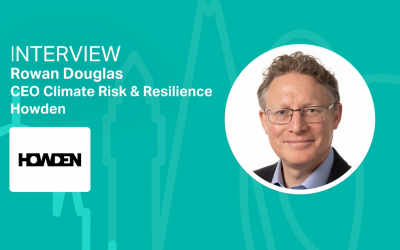Sérgio Goulart Machado on the important role hydrogen will play in the energy transition
Ahead of the Hydrogen Transition Summit, Climate Action caught up with, Sérgio Goulart Machado, Director of Global Business Development and PMO for Hydrogen at Galp to discuss the important role hydrogen will play in the energy transition.

Ahead of the Hydrogen Transition Summit, Climate Action caught up with, Sérgio Goulart Machado, Director of Global Business Development and PMO for Hydrogen at Galp to discuss the important role hydrogen will play in the energy transition.
So, why is hydrogen so important for Galp?
There is simply no way to achieve a successful energy transition in time to stop climate change without a large-scale deployment of hydrogen. In the coming decades, we will need to use everything we’ve got in our toolbox – renewables, carbon capture and storage, energy efficiency… Hydrogen, not an energy source in itself, offers a way to deal with many of the shortcomings of the current clean primary energy sources. It also brings the other solutions together and allows them to reach some areas or industries for which electrification won’t become a practicable solution within the visible timeframe.
Through green hydrogen, we can bring renewable energy to long-haul transportation, to aviation and shipping; it will play a growing role in the climatization of buildings; it is also a way to store renewable electricity, through hydrolysis.
And while other technologies may also offer competitive alternatives to decarbonize these sectors – such as biofuels or batteries – there are areas for which there is no solution other than hydrogen, such as bringing high-grade heat to industries like steel or cement, to decarbonize industrial feedstocks and to produce ammonia for fertilizers.
Galp is already one of the largest Iberian industrial hydrogen consumers, in its refineries and it´s involved in a large-scale green hydrogen production project just south of Lisbon, in Sines, powered by the best solar exposure in Europe. The Sines project will allow us to start experimenting with this future market and to understand the leverages, economics, technology, transport, and storage risks as well as future market needs.
We are also identifying partners to develop green H2 projects in other areas that are important to us.
What kind of projects and what sort of partners?
The green hydrogen industry is a nearly clean slate, so we are open to team-up for anything that will make sense to us, providing that the project fulfills several conditions that to us are crucial:
- It needs to have scale, because if we want to make a difference, we need to aim high.
- We’re also looking preferably to projects that are in the money without the need for state grants – although we have nothing against the financial support packages available for hydrogen, particularly in Europe, we’d rather tag along in project for industries that can absorb and pass-along the cost of hydrogen. Clean steel is an industry that comes to mind, as are fertilizers.
- It needs to have a fit with our industrial profile or with our profile as an integrated energy company.
As for the partners, we are looking for companies with expertise in their areas that may be complementary with our own.
And what would Galp offer in return?
We are a leading energy company with extensive experience in very large-scale engineering projects – we manage one of the largest industrial complexes in Iberia – but also the giant upstream projects that we share with the world’s top energy companies, including Shell, Exxon, Total, Petrobras, Eni and many others. We know what it takes to successfully develop complex projects whose timeframe spans decades.
We also have a track record of innovation – we operate our country’s largest electric-car charging network; we are applying AI tools to decentralized solar PV for self-consumption, through a newly created unite, Energia Independente; we also launched a ground-breaking integrated shared-fleet management system through GoWithFlow that includes management of the charging infrastructure – and this was all before we even opened UP-Upcoming Energies, which is our brand new innovation lab…
We also offer a best-in-class location for green hydrogen production, benefiting from an outstanding solar exposure, wide-open spaces for the installation of industries, solar plants, or infrastructure, all by a deep-water seaport with much capacity to spare.
As the largest solar PV producer in Iberia, we also have a large-scale presence in solar PV, which may be paramount for the development of competitive green hydrogen projects.
The Portuguese government is also fully committed with the energy transition, with the hydrogen economy and with supporting new industries looking to set-up in the country.
Can you tell us a little more about Galp, for people – and maybe even potential partners – who may be less familiar with the company?
I appreciate that opportunity… Galp is an integrated energy company with a long history, whose most recent landmark was becoming the largest photovoltaic producer in Iberia by acquiring the solar energy pipeline of Spain’s ACS group, who remains our minority partner in that business. At the end of the third quarter last year, we had 1 GW in operation, and we are committed to continue fostering that business, aiming to more than triple our current production by 2024.
Our quick transformation is powered by our upstream business, which is anchored in Brazil’s giant pre-salt projects, which are amongst the most productive and competitive in the world. We are also developing the large natural gas discoveries off the north coast of Mozambique, which are uniquely positioned to supply the Indian and Southeast Asian markets for many decades. We also have a strong downstream presence in the Portuguese-speaking African countries, including Angola and Mozambique. We have a presence in 11 countries. Our financials are strong, and we have the support of our shareholders to speed-up our transformation and help bring about the so awaited energy transition.
That’s Galp in a nutshell. A company with a long history that traces its roots to the 19th century, but full of stamina – and very excited to contribute to the reshaping of the energy industry.
So how do you see hydrogen contributing to your business?
Simply put, the energy transition challenge is to provide all the increasing amount of energy the world demands in a cleaner, safer, and cheaper way. For that, we must act on four major pillars: more efficiency; more renewables; cleaner energy carriers; and carbon capture and storage.
H2 can have an unparalleled role as a clean energy carrier. It will not be the only one, because electrification is here to stay. But it can complement electricity where electrification is more challenging. Under some scenarios, in 30 years, hydrogen may account for a similar share of the world’s energy consumption that electricity does today.
As an energy company, we need to be able to deliver the energy that our clients need in the most competitive and flexible way, whatever its type, form, or shape will be.
What role can hydrogen play in that mix?
To start with, it allows us to integrate our renewable assets with the other business units. It works as a link between sectors, between energy value chains and even between regions. It works for short-term storage, which is important to balance the energy system, but it can also help us flatten the seasonality curve, because we can build-up green hydrogen reserves in the summer, when solar light is more abundant, to use it in winter.
If we really want to help decarbonize the economy, and our clients’ businesses, then we need H2... electricity is not a solution for everyone. Not for heavy duty and long-haul transport, certainly not for aviation and marine. In industry, we have high grade heat, and we have H2 as feedstock that needs to be decarbonized. And we have the buildings. And for all this hydrogen is incredibly flexible.
And these are just some of the already known cases in which hydrogen is clearly the most promising solution. Now, if we add to this picture decentralized green hydrogen, produced locally with a smaller scale electrolisers powered by solar panels, we’re opening a whole new frontier of clean solutions for which – once the cost curve comes down – the only limit is our imagination.
We are looking at all these exciting new areas because the disruptive opportunities are endless and we believe we can play an important role, as an integrated energy company, in bringing these solutions to market on a wide scale.
What, in your view, are the major obstacles for hydrogen’s success?
Low carbon hydrogen is not yet competitive with grey hydrogen or with other clean energy carriers. We strongly believe that technology – combined with scale and massification – will contribute to make the hydrogen cost-cutting curve steeper. But we need all the right conditions to be in place, whether in the form of investment grants, exemption of power grid tariffs, or carbon taxes, just to mention a few.
On our side, we need to make sure that the projects we design have access to the lowest-possible electricity cost, large scale, high load-factors, and no over-investment on the initial infrastructure.
We certainly have better starting conditions in Portugal than anywhere else in Europe to make all of this happen – including political and social stability, which is an increasingly important factor.
We are now focused on identifying and attracting the right value chains as we look for partners or off-takers who may be better able to value low carbon hydrogen. We are sure that these will not take long to see that what we can offer is very difficult to replicate more competitively.
There have been previous waves of excitement about hydrogen that never materialized. What makes you believe things will be different this time around?
We are seeing many converging trends which are fundamental for this to happen that were not there before:
- We have an urgent need to act on climate change, and we have a broad consensus about it among governments, companies, and the people in general. Everyone is committed and aware of the costs, both of changing, and of continuing with business as usual.
- We have cheap electricity because of the dramatic drop in the cost of solar panels and wind turbines, and that, combined with the drop in the costs of hydrolysis – which has declined 60% in the past 10 years and is expected to drop an additional 50% in the coming decade – allows us to anticipate that green hydrogen may soon be competing head-to-head with grey and brown hydrogen.
- With country after country putting in place their own national hydrogen strategies – and with strong political and financial support from the European Union, but also elsewhere in the world – we are looking at a strategic push that’s too strong to be derailed.
- That push is also replicated at the corporate level, not just in the energy industry, but at every imaginable sector that simply does not want to be left behind.
The stars are aligned for H2 and Galp is ready for launch.
Galp co-leads one of Europe’s largest green-hydrogen projects. It benefits from the cheapest solar energy in Europe, a long history of innovation and a strong partnership culture.
Sérgio Goulart Machado will be speaking at the Hydrogen Transition Summit on the 25 February. Learn how we can make the hydrogen hype a reality by registering for free today. Can't make it? You can still register today and you will receive a link to watch the sessions on demand.






